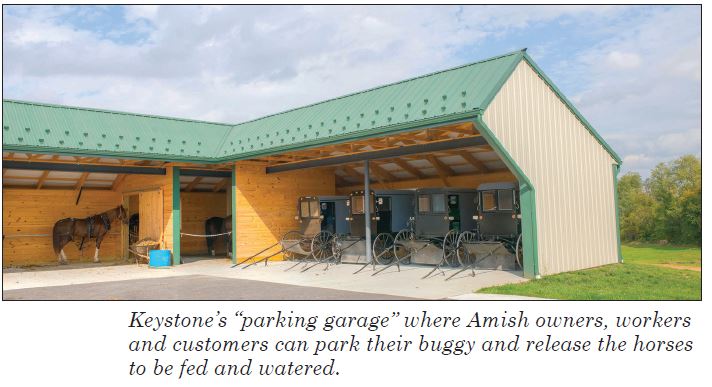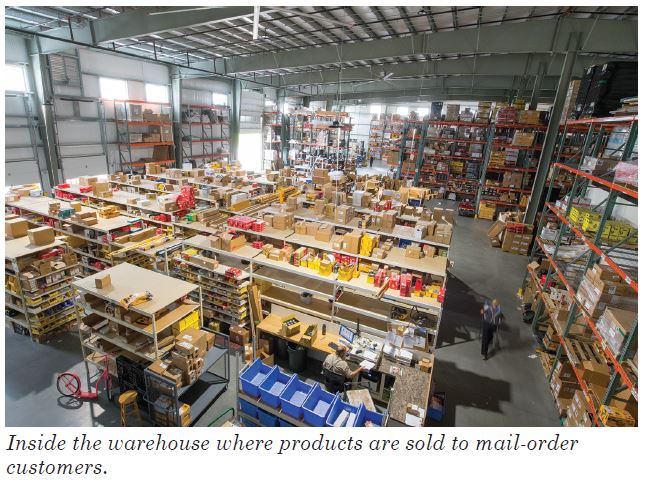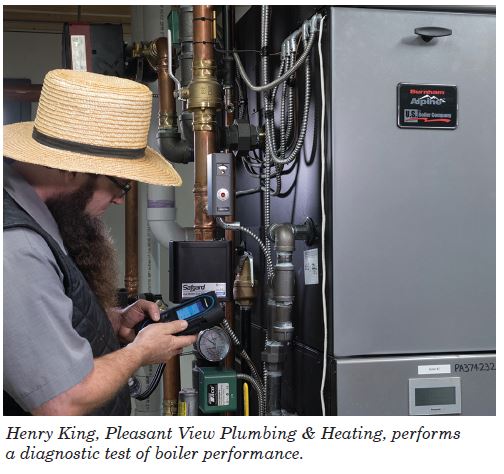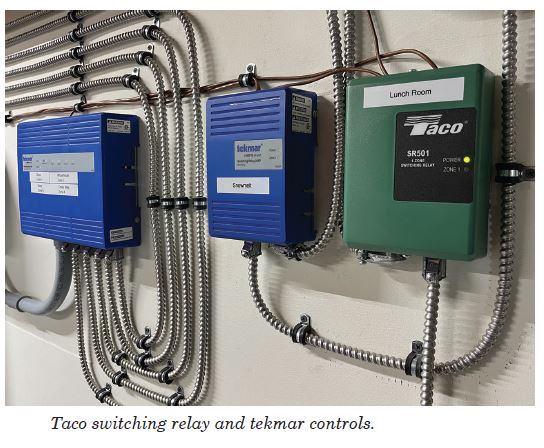Written on: July 8, 2024 by Dave Raabe
Visitors flock to the heart of Amish Country in South Central Pennsylvania to see Amish plowing fields with teams of mules, or riding around in quaint horse-drawn buggies. Little would they know that many Amish these days carry a cell phone and readily use power tools during those famous barn raisings—as long as they’re powered by battery.
Those visitors might also be surprised to know that Keystone Air Power, one of Lebanon County’s fastest-growing hardware stores, is a robust Amish enterprise that’s chock full of surprises. The new, fully-modern facility is a marvel of self-sustaining and energy-efficient design. The sprawling, 52,000 sq ft building was constructed around a cutting-edge, off-grid mechanical and electrical system.
The Amish, it appears, know a thing or two about smart technology.
Parking Garage for Horses
One of the things a first-time visitor to the store would see that sets it apart from, say, the Big Box Retailer that is just a stone’s throw from the main entrance, is a horse and carriage facility. Somewhat like a redefined parking garage, it is exactly what one might expect to see on a rerun of Little House on the Prairie.

There, horses can be tethered for a quick bath, bite to eat and watering. Carriages have parking spaces under roof. In Winter, after seeing to the comfort of their horse, customers make their way into the store across a snow-melted concrete slab. With a close look, they’d spot one of two embedded, shiny brass sensors that monitor temperature and moisture. Each sensor sends signals to a state-of-the-art tekmar 654 snowmelt control for full automation of hydronic heat to keep outside spaces free of Winter precipitation.
Inside the store, there’s a veritable mountain of modern, lithium-powered tools—the envy of every power tool enthusiast—from chain saws, sanders, impact drivers, drills and carpentry saws, to nail guns and grinders. A shiny array of hand tools and components are meticulously arranged on shelves and in bins.
Every imaginable air tool can be found inside Keystone Air Power: pressure equipment with tanks that create pneumatic power, a wide variety of hoses and connectors to transport pressurized air, and a broad selection of pneumatic tools—from cutters and leather-stitching components, to needle valves, nailers, nibblers and nippers.

Living Productive Lives
The Amish view technology (and the right mix of tools) as ways to make their lives more productive—never as a distraction from their beliefs. While it’s rarely used in their personal lives, technology, when applied properly, may also play an important role in an Amish business. Wireless phones and computers help Amish business owners connect with customers and suppliers, allowing them to grow and thrive in the modern world. The key to their use of tech is to have no dependence on outside infrastructure; no tether to grid power means no distraction from their faith, allowing the Amish to be modern in many ways while remaining true to their beliefs and traditions.
Keystone Air Power LLC began in 1997 in Jonas Zook’s basement workshop. There, he fixed and sold tools and air compressors for local contractors, woodworking shops, farmers and homeowners. The following year, he moved to a larger building—a horse barn. By 2002, DeWalt, Stanley and Black+Decker all recognized him as a dealer and repair center. A few years later, Zook, who by then had a growing number of employees, moved operations into an 18,000 sq ft facility.
Today, Keystone has 25 full-time employees, a handful of part-timers, links to Porter Cable, Bosch, Milwaukee Tools, Bostitch, Hitachi and Makita, and a $5 million inventory. Nearly two decades after its founding, a steady growth of the business led to the need for a bigger, fully-modern, off-grid facility—an accomplishment borne of deliberate planning.
King-Sized Hydronics
The Amish know and appreciate hydronic heat. While planning its new, customized facility, Keystone’s managers chose Henry King, owner of Kirkwood, PA-based Pleasant View Plumbing & Heating, to do the plumbing and hydronic systems.
Once King had a sense of the size and complexity of the project, he reached out to our manufacturer’s representative firm, ROI Marketing based in Millersville, MD, with questions about equipment selection and system design. Those questions were right up our alley, as many Amish and Mennonite customers call on us routinely for design help, materials and equipment.

“This was a large project for us, about equal in size to one other commercial facility that we completed a few years earlier—yet with some really neat differences, like the substantial snow-melt area and the provision of co-gen heat,” said King.

King is referring to the installation of two natural gas-powered electric generators housed in a lower portion of the facility. There, a 225 kW and 141 kW generator power-up, as needed, supplies energy to a bank of Schneider Electric inverters and batteries. Waste heat from the smaller generator is harvested by a plate-and-frame heat exchanger. When the generator can’t provide sufficient heat for the facility, the responsibility shifts to equipment in the upstairs mechanical room. There, two stacked, 800 MBH, natural gas-fired Alpine commercial boilers by U.S. Boiler Co. await a signal from tekmar controls and thermostats.
The up-to-97% AFUE, low NOx Alpine condensing boilers are equipped with advanced technologies to constantly monitor performance and match fuel consumption directly to heating demand. The Alpine incorporates outside temperature sensing technology that automatically adjusts the firing rate of the boiler based on the outside air temperature—and the availability of heat from the generator.
The boilers are also equipped with U.S. Boilers’ Sage 2.3 boiler control system, which includes a built-in sequencer for internal staging of up to eight Alpine boilers. The Alpine line offers 80 to 800 MBH in 10 sizes, many of which may also be wall-hung.
When running, the generator provides up to 80,000 BTUs as a free-heat source for the building’s radiant heat system. Thermal energy (at a provision of 180°F) is transferred from the heat exchanger to the return loop, where it’s mixed to much lower temperatures suitable for radiant comfort—delivered by more than seven miles of ¾-inch oxygen-barrier PERT tubing in the high-mass floor slab. This allows the generator to serve as the primary source of heat when running, but also to reduce the firing rate of the boilers if both systems are operating simultaneously. Combining the heat sources was accomplished without disrupting the typical 20-degree ∆T, maintaining the boilers’ ability to condense for highest operational efficiency.

Hajoca Takes the Stage
Hajoca Corp. of Lancaster, PA, brought the boilers to the site months earlier, along with pumps, radiant and snowmelt manifolds, components and fittings. A bevy of circulators were used for the hydronic system—most connected via press fittings to 1″ and 1½″ copper.
Together, King and I selected tekmar 304P multi-switching relays for the in-floor radiant heat, while a tekmar 301P single-zone switching relay was used for the snowmelt.
King and Pleasant View technicians Jim Mellot and Samuel Zook began work in November 2022, and completed the job seven months later, providing radiant heat for most of the first floor, upstairs lunchroom, and 4,500 sq ft of snowmelt outside.
“We’re delighted that we were chosen by Keystone to do this job,” said King.
“We get a good feeling every time we come here to provide seasonal service for the equipment, or to buy tools. We’re among friends here.” ICM
Dave Raabe is Co-Owner & Sales Manager at ROI Marketing, a manufacturer’s representative firm covering the Mid-Atlantic region. An industry veteran with 30 years of experience, Raabe has extensive knowledge of hydronics, heating system design and pumping systems, including domestic hot water boosting and recirculation.